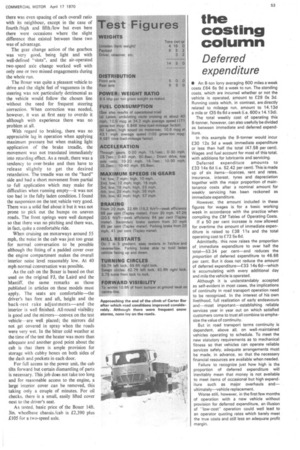the costing column
Page 55

If you've noticed an error in this article please click here to report it so we can fix it.
Deferred expenditure
• An 8-ton lorry averaging 600 miles a week costs £64 6s 9d a week to run. The standing costs, which are incurred whether or not the vehicle is operated, amount to £29 Os 3d. Running costs which, in contrast, are directly related to mileage run, amount to 14.13d a mile or £35 6s 6d a week (i.e. 600 x 14.13d).
The total weekly cost of operating this 8-tonner, however, can also usefully be divided as between immediate and deferred expenditure.
In this example the 8-tonner would incur £30 12s 3d a week immediate expenditure or less than half the total (47.58 per cent). Wages and fuel account for most of this total, with additions for lubricants and servicing.
Deferred expenditure amounts to £33 14s 6d (i.e. 52.42 per cent). This is made up of six items—licences, rent and rates, insurance, interest, tyres and depreciation together with the major proportion of maintenance costs after a nominal amount for weekly servicing has been reckoned as immediate expenditure.
However, the amount included in these figures for wages is for a basic working week in accordance with the practice when compiling the CM Tables of Operating Costs.
If a 50 per cent increase is now allowed for overtime the amount of immediate expenditure is raised to £38 11s and the total operating cost to £72 5s 6d.
Admittedly, this now raises the proportion of . immediate expenditure to over half the total-53.34 per cent—and reduces the proportion of deferred expenditure to 46.66 per cent. But it does not reduce the amount of deferred expenditure—£33 14s 6d—which is accumulating with every additional day and mile the vehicle is operated.
Although it is understandably accepted as self-evident in most cases, the implications of continuity in road transport operation need to be recognized. In the interest of his own livelihood, full realization of early endeavours and—most important—establishing reliable services year in year out on which satisfied customers come to trust all combine to emphasize the value of continuity.
But in road transport terms continuity is dependent, above all, on well-maintained vehicles operating to schedule. To meet the new statutory requirements as to mechanical fitness so that vehicles can operate reliable services safely, adequate arrangements must be made, in advance, so that the necessary financial resources are available when needed.
Failure to recognize just how high is the proportion of deferred expenditure will inevitably mean that money is not available to meet items of occasional but high expenditure such as major overhauls andultimately—vehicle replacement.
Worse still, however, in the first few months of operation with a new vehicle without provision for deferred expenditure, an illusion of "low-cost" operation could well lead to an operator quoting rates which barely meet the true costs and still less an adequate profit margin.












































































































